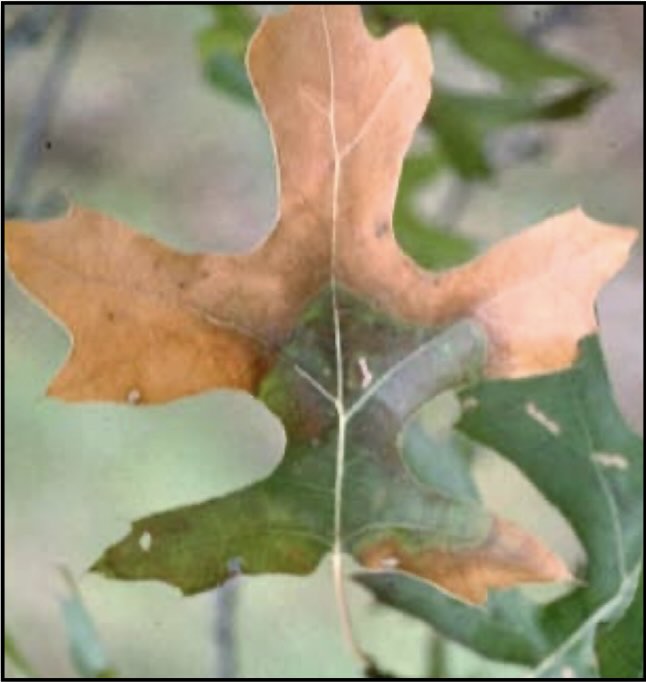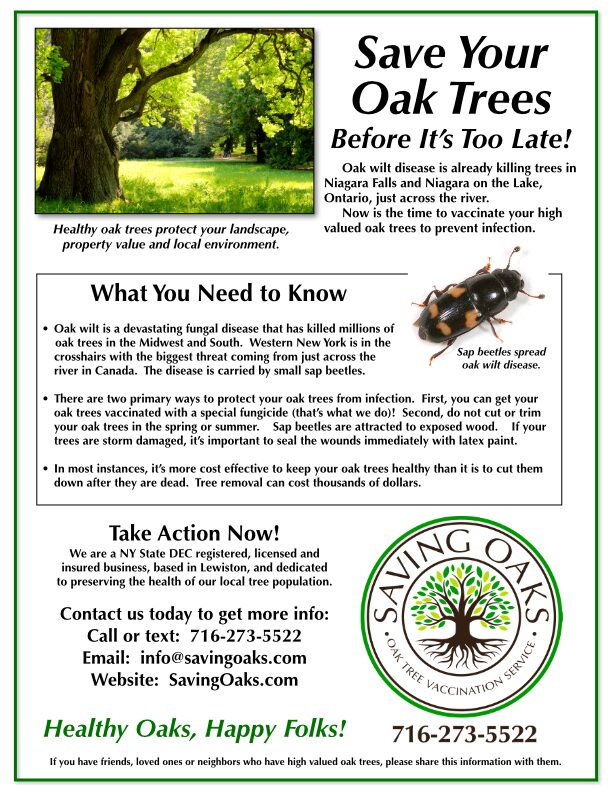
Oak Wilt Disease Is About To Invade Western New York
Saving Oaks is dedicated to saving high-valued oak trees from the ravages of oak wilt disease in Niagara County and Erie County, New York. Prevention is the key. Your best option is to have your oaks professionally vaccinated (injected) to minimize the threat of oak wilt disease. Otherwise, you may be faced with greater expenses cutting down and removing the trees after they they have been killed by the fungus. If you have a valued oak tree, or a grove of trees that you want to save, get your name on the reservation list and make arrangements to protect your trees.
You may recall that thousands of ash trees have been killed over the past few years because of the emerald ash borer. Oak trees will be facing the same fate with the oak wilt fungus. Make plans to save your oaks today.

Call us today to discuss how you can protect your oak trees from oak wilt — a devastating fungal disease that threatens to destroy thousands of oak trees in Western New York.
Call Us: 716-273-5522
What You Need to Know
Oak wilt disease is widespread and has already wiped out millions of trees in two dozen states, particularly in the Midwest. Looking at the spread and trajectory of the disease, Western New York is next in line to feel its effect.
There are a few important things you should know about oak wilt disease
- The best way to reduce oak tree mortality is to vaccinate the tree with fungicide which acts as a preventive.
- Once infected, there is nearly a 100% mortality rate for red oaks. The death timeline varies, from several weeks to months. White oaks are more resistant, and symptomatic white oaks have a chance of surviving with proper treatment.
- The culprit is a fungus called Bretziella fagacearum, which blocks the tree’s vascular system, preventing water and nutrients from reaching the leaves. It is spread by various kinds of sap beetles, intermingled oak root systems, or workers transmitting the fungus on their tools. DO NOT prune your oak trees during the growing season. Only prune from October to March.
- Trees can be vaccinated by injecting them with special fungicide. These treatments should be continued every 1 to 3 years depending on the level of threat, or until the threat has passed.
- A major problem: Firewood! Transporting infected firewood from one location to another spreads the oak wilt pathogen.
Contact Us
Oak Wilt – Frequently Asked Questions
What Is Oak Wilt?
Oak wilt is a destructive fungal disease that attacks oak trees. The fungus invades the tree’s water-conducting system, essentially clogging it, which causes the tree to wilt and eventually die. It is one of the most serious tree diseases in the United States and can kill an oak very quickly — in some cases, infected oak trees, especially red oaks, die within just a few weeks of showing symptoms.
What Should I Look For To Determine If My Tree Has Been Infected?
Look for wilting leaves that turn bronze or brown, from the outside edges and moving inward. The top of the tree will start losing leaves rapidly. You may notice dark vertical streaks in the bark. Underneath the bark you may see dark “fungal mats” that emit a sweet smell. Some people think it smells like Juicy Fruit gum. Unfortunately, for trees in the red oak family (northern red oak, pin, black, scarlet oak), once symptoms are present, the trees are impossible to save. That’s why prevention is so important. If you think you see symptoms, contact us immediately!

edges and move inward.
How Does Oak Wilt Spread?
Oak wilt spreads in two main ways — above ground and below ground. Above ground, sap-feeding beetles transport the oak wilt fungus from infected trees to healthy ones. They are attracted to the sap of fresh cuts or wounds on an oak. If a beetle carrying fungus spores lands on a recently pruned or injured oak, it can infect that tree. This risk is highest in spring and early summer when these beetles are most active. Below ground, oak wilt moves through interconnected roots. Adjacent oak trees often have roots that graft (grow together), so the fungus can travel underground from a sick tree to its neighbors.
Can a Tree Be Saved Once It’s Infected With Oak Wilt?
Unfortunately, once an oak in the red oak family (northern red oak, pin or black oak) is infected, it is impossible to save. Red oaks can die within weeks. However, there is a chance to save trees in the white oak family (white oak, bur oak, and others) if caught early enough with professionally applied fungicide injections. For example, if less than 30% of the tree’s crown has wilted, a fungicide injection might help a white oak survive. Again, there are no guaranteed cures once a tree has been infected.
What Types Of Oaks Are Most At Risk From Oak Wilt?
All oak species can get oak wilt, but some types are more vulnerable than others. Trees in the red oak family (northern red oak, pin or black oak) are at the highest risk. Red oaks are very susceptible to the fungus and often die rapidly when infected. Trees in the white oak family (white oak, bur oak, and others) have more natural resistance. White oaks usually don’t get as sick as fast — they may survive for a longer time with the disease and sometimes only part of the tree is affected instead of the whole tree. In fact, some white oaks can survive the disease and only suffer some limb loss. In summary, red oaks are the most vulnerable and can die quickly. White oaks are more tolerant but still deserve preventative treatments.
What Preventative Measures Can Be Taken To Protect High-Valued Oak Trees?
The best preventative approach is to get your trees vaccinated. These injections, performed by state licensed professionals, can significantly reduce the chance of a tree getting oak wilt, or slow the disease if the tree has been recently infected. Proper pruning practices are another crucial preventive measure. Oak wilt often enters a tree through open wounds, so it’s very important not to prune oaks during the spring and summer when the fungus is spreading. If a tree is wounded, from pruning or storm damage, seal it immediately with latex paint or wound sealer to block out insects and spores.
How Much Does It Cost To Have a Tree Vaccinated?
The rate for preventative treatment is $14 per diameter inch. For example, if your tree trunk is 20 inches wide (at 4 feet above the ground) it would cost $280 to treat. (20 inches x $14 = $280). There are discounts for treating multiple trees at once. There may be extra travel charges if outside our immediate service area. Generally speaking, it is recommended your trees be treated every 2-3 years until the threat has passed. More often than not, it’s less expensive to vaccinate your tree than it is to have it cut down and removed after it’s dead.
Steps To Protect Your Oak Trees From Oak Wilt.
There are several practical steps you can follow to guard your oak trees against oak wilt. Here are some of the most important actions:
- Consider preventative vaccinations for high-valued oaks. If oak wilt has been found in your area, you might protect your healthy oak trees by having them professionally injected with a fungicide. This helps the trees resist oak wilt infection.
- Avoid pruning or trimming oak trees in spring and summer. This is when oak wilt is most easily spread by sap-feeding beetles that can smell oak wounds miles away. If you must prune during this time, for example, for safety or storm cleanup, apply a tree wound sealer or latex paint to the cut immediately after pruning.
- Clean your tools between pruning different trees — disinfect your pruning saws and clippers with rubbing alcohol or a household disinfectant (like Lysol or Pine-Sol) between trees. This prevents possibly transferring the fungus from one tree to another on your tools. Household bleach is not recommended for tool cleaning because it can corrode tools.
- Don’t move or store infected oak wood (firewood) — oak wilt can spread through fungal mats on wood from diseased oaks. Avoid moving oak firewood out of an area where oak wilt is present.
By following these steps, property owners can significantly reduce the risk of oak wilt infecting their trees. Prevention and quick action are the best tools to keep your oak trees healthy and safe from oak wilt. Remember to also stay informed about oak wilt in your region. Contact us if you suspect oak wilt has invaded your property. We also work with the state forestry service and the local cooperative extension offices for support and guidance.
